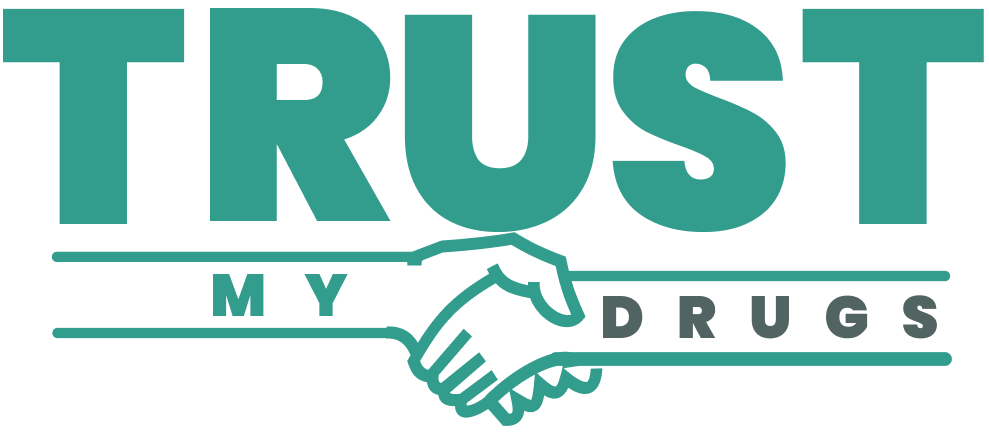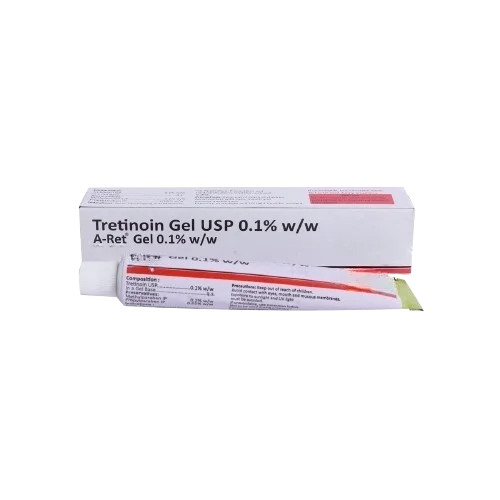This FDA-Approved acne and Anti-Aging cream is the Strongest Topical Retinoid Available. A Ret Gel promotes faster skin cell turnover, increases Collagen Production for Anti-Aging, and fights acne at the root. It is scientifically stronger than Retinol and other Retinoids, providing long-term skin benefits.
What is A RET GEL 0.1%?
A-Ret Gel 0.1% contains Tretinoin (0.1%), a potent Vitamin A derivative that accelerates skin renewal, clears acne, and reduces wrinkles. It works at the cellular level to improve skin texture, tone, and clarity.
The Science Behind Tretinoin (A-Ret Gel 0.1%)
Speeds Up Skin Cell Turnover
Skin cells take 28-40 days to renew. Tretinoin accelerates this process, making skin shed old, damaged cells faster and replace them with new ones. A Ret Gel helps with acne, scars, hyperpigmentation, and dull skin.
Unclogs Pores & Treats Acne
A Ret Gel prevents dead skin cells from blocking pores, reducing breakouts. Reduces oil (sebum) production, making skin less oily and prone to acne. It kills acne-causing bacteria by creating an oxygen-rich environment where bacteria cannot survive.
Stimulates Collagen Production (Anti-Aging Effect)
Tretinoin boosts collagen, which naturally declines with age. Reduces fine lines, wrinkles, and sagging for firmer, plumper skin. It helps improve skin elasticity and smoothness over time.
Fades Hyperpigmentation & Dark Spots
A Ret Gel breaks down excess melanin (skin pigment), helping to fade acne scars, sun spots, and melasma. It evens skin tone and texture.
Reduces Large Pores & Improves Skin Texture
Regular use tightens pores, making skin look smoother and refined. It helps with rough, bumpy skin and uneven texture.
How Long Does It Take to Work?
First signs of improvement: 2-4 weeks (mild peeling, skin purging may happen). Acne & texture improvement: 6-8 weeks. Anti-aging & hyperpigmentation effects: 3-6 months. Full results: 6-12 months of consistent use.
What are the Uses and Benefits of A RET GEL 0.1%?
Uses of A-Ret Gel 0.1%
Acne Treatment
Unclogs pores and prevents breakouts. A Ret Gel reduces blackheads, whiteheads, and deep cystic acne and controls excess oil (sebum), reducing acne formation.
Anti-Aging & Wrinkle Reduction
Stimulates collagen production, reducing fine lines and wrinkles.
Improves skin firmness and elasticity, preventing sagging.
Hyperpigmentation & Dark Spot Removal
A Ret Gel fades acne scars, melasma, and sunspots by breaking down excess melanin. It brightens dull skin and evens out skin tone.
Pore Tightening & Skin Texture Improvement
Shrinks large pores, making skin smoother and refined. It helps with rough, bumpy skin and uneven texture.
Exfoliation & Skin Renewal
Speeds up skin cell turnover, replacing old, damaged skin with fresh new skin. A Ret Gel enhances the absorption of other skincare products.
Benefits of A-Ret Gel 0.1%
- FDA-approved and dermatologist-recommended for acne & anti-aging.
- A Ret Gel works better than over-the-counter retinol (which is weaker and takes longer to show results).
- Clinically proven to improve skin texture, tone, and clarity.
- A Ret Gel provides long-term skin benefits with continuous use.
- It helps prevent new acne breakouts while treating existing ones.
- A Ret Gel gives skin a youthful glow by making it smoother and brighter.
What are the Safe Dosages of A RET GEL 0.1%?
A-Ret Gel is not oral. It is a topical treatment applied directly to the skin. The dosage refers to how much and how often you use it.
Standard Dosage & Application
- Apply a pea-sized amount (around 0.5g) to the entire face once daily.
- Use at night before bedtime (Tretinoin makes skin highly sensitive to sunlight).
- Massage gently until fully absorbed.
- Avoid the eyes, mouth, and nostrils (apply only to affected areas).
Duration of Treatment
- First signs of improvement: 2-4 weeks (may experience mild peeling & purging).
- Acne & texture improvement: 6-8 weeks.
- Wrinkle reduction & skin brightening: 3-6 months.
- Full results: 6-12 months of consistent use.
Special Dosage Considerations
If you are using it for the first time
Start with a lower frequency (2-3 times a week) to allow skin to adjust. Increase gradually to once daily if tolerated.
For sensitive skin
Use the "sandwich method" (Use moisturizer before and after A-Ret Gel) to minimize irritation. Use 0.05% or 0.025% Tretinoin if 0.1% is too strong.
If you miss a dose
Apply the next night—do not double the dose to catch up for a missed one.
How Do I Use A RET GEL 0.1%?
Correctly applying A-Ret Gel is crucial to maximize benefits and minimize irritation. Since it is a strong retinoid, your skin needs time to adjust.
Step-by-Step Application Guide
Step 1: Wash & Dry Your Face
Use a gentle, non-irritating cleanser (avoid scrubs or harsh exfoliants).
Pat skin completely dry (wait 10-20 minutes before applying).
Applying it on damp skin increases irritation.
Step 2: Apply a Pea-Sized Amount
Squeeze only a pea-sized amount (too much can irritate).
Dab small dots on the forehead, cheeks, nose, and chin, then gently spread evenly.
Step 3: Avoid Sensitive Areas
Do NOT apply near the eyes, nostrils, mouth, or broken skin.
Avoid neck and eyelids unless prescribed.
Step 4: Use at Night (Before Bed)
A-Ret Gel makes skin very sensitive to sunlight, so only apply at night.
Do NOT mix with other active ingredients like benzoyl peroxide, vitamin C, or AHAs/BHAs unless your doctor suggests.
Step 5: Moisturize & Use Sunscreen Daily
Use a moisturizer after 20-30 minutes to reduce dryness.
Apply a broad-spectrum sunscreen (SPF 30+ or higher) every morning—Tretinoin makes skin extremely sensitive to UV rays.
How Often Should You Use It?
First-time users → Start 2-3 times a week (every other night).
After 2 weeks → If it does not irritate your skin, increase the use to every night.
Long-term use → Use consistently for 6-12 months for best results.
Tips to Avoid Irritation & Peeling
- Start slow. Let your skin adjust before using daily.
- Use the sandwich method – Apply moisturizer before and after Tretinoin if irritation occurs.
- Do not overuse – A pea-sized amount is enough for the whole face.
- Avoid other exfoliants – Do not mix with AHAs, BHAs, Vitamin C, or benzoyl peroxide unless a doctor recommends it.
- Be patient – It takes weeks to months to see full results.
When Should I Avoid A RET GEL 0.1% or Use A RET GEL 0.1% Cautiously?
When to AVOID A-Ret Gel 0.1% Completely
If You Have Extremely Sensitive or Damaged Skin
Avoid A Ret Gel if you have eczema, rosacea, psoriasis, or open wounds, as it can cause severe burning and irritation.
If you are Pregnant or Breastfeeding
Tretinoin is a Category C drug, meaning it may cause defects at birth.
Not safe for use during pregnancy or breastfeeding—consult your doctor for alternatives.
If You Have a History of Severe Allergic Reactions
Avoid A Ret Gel if you have had skin allergies or reactions to retinoids before.
If You Are Using Other Strong Skincare Actives
Avoid A Ret Gel mixing Tretinoin with:
- Benzoyl Peroxide (may deactivate Tretinoin)
- AHAs/BHAs (Glycolic Acid, Salicylic Acid)
- Vitamin C (it can irritate)
- Strong exfoliants (chemical peels)
If You Have Recent Sunburn or Skin Irritation
Tretinoin makes skin very sensitive to sunlight, so wait until your skin heals before starting.
When to Use A-Ret Gel 0.1% Cautiously
If You Are New to Retinoids
Start with a lower strength (0.025% or 0.05%) before moving to 0.1%.
Use only 2-3 times a week initially, then increase gradually.
If You Have Dry or Dehydrated Skin
Use the sandwich method (moisturizer before and after A-Ret Gel) to reduce dryness.
If You Are Exposed to Sunlight Frequently
Always wear sunscreen (SPF 30+ or higher), as Tretinoin makes skin highly sensitive to UV damage.
If You Experience Peeling or Redness
Reduce application to every other night if irritation occurs.
Avoid harsh skincare products that can make irritation worse.
What are the Side Effects of A RET GEL 0.1%?
Common A RET GEL 0.1% Side Effects
- Skin Dryness & Peeling – Your skin may feel tight, flaky, or scaly, especially in the first few weeks.
- Redness & Irritation – Mild redness, sensitivity, or a slight burning sensation is normal.
- Skin Purging – Temporary increase in acne breakouts as pores unclog (usually lasts 2-6 weeks).
- Increased Sun Sensitivity – Skin becomes more prone to sunburn, making sunscreen (SPF 30+) a must.
- Mild Stinging or Burning – You may experience discomfort if applied to damp skin.
Severe A RET GEL 0.1% Side Effects
- Severe Peeling or Crusting – If skin starts cracking or blistering, stop use and consult a doctor.
- Severe Redness or Swelling – Excessive inflammation could indicate an allergic reaction or overuse.
- Skin Discoloration (Hypopigmentation or Hyperpigmentation) – Some users may develop dark or light patches, especially with sun exposure.
- Extreme Sensitivity or Pain – Reduce usage or stop if the skin becomes extremely sensitive, painful, or irritated.




